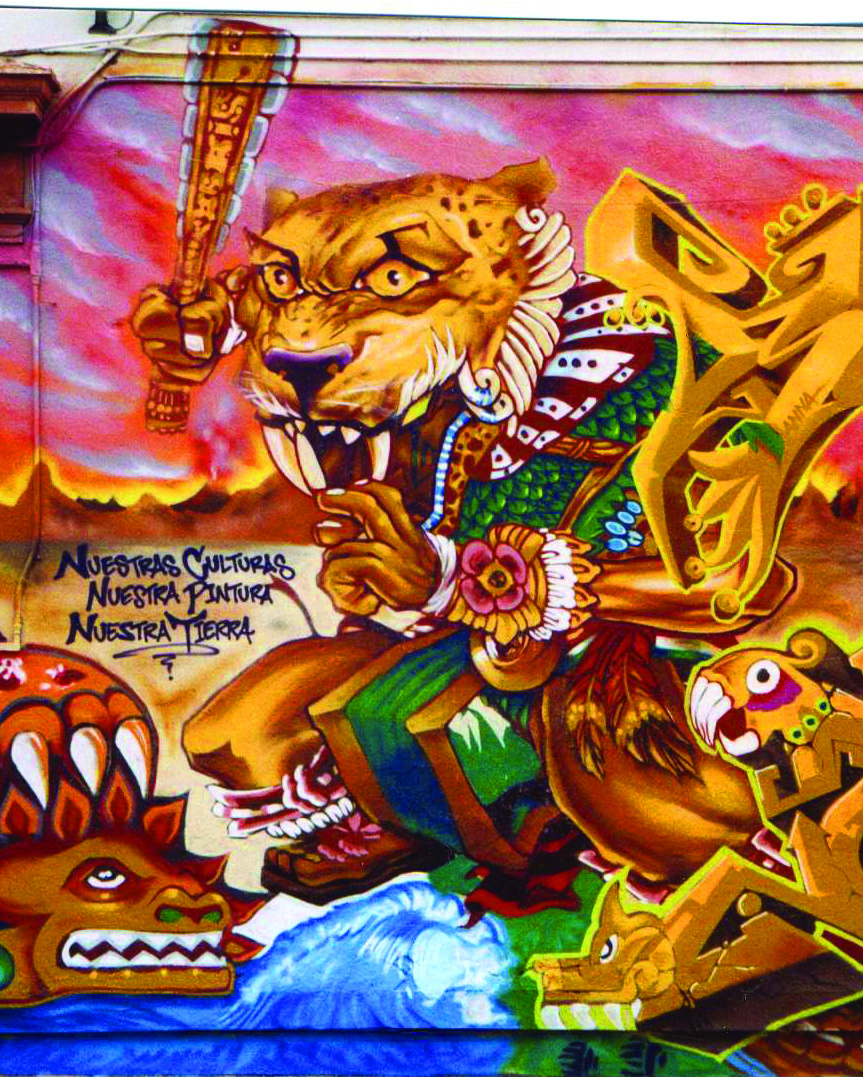If you live in San Francisco and pay attention to public art, you might already be familiar with the work of longstanding Bay Area graffiti crew Inner City Phame (ICP). Their prolific murals – diverse in style and magnetic in form – grace walls across the city. There’s a tribute to Malcolm X on Third and Kirkwood in Bayview-Hunters Point, featuring intricately crafted aliases free floating among inspired quotes. On a vibrant wall on the corner of 19th and Mission, comic book characters from Ironman to Dr. Evil swing between stylized names forged in cracked stone. An Azteca-themed mural up the street on 25th has a jaguar warrior getting down with the gods. And ICP also curates the street level walls of the Defenestration building on 6th and Howard (that old tenement hotel with furniture flying out of the windows), making a dynamic open-air gallery out of abandoned space. Wait, who said graffiti wasn’t art?
“The first graffiti I saw when I was a kid growing up in the Mission was the Chicano writing on our walls,” says Twick, ICP veteran and original member of the group of close-knit friends, founded by Il Charo (then named Jes 446) back in 1988. “We called it Cholo writing, because that’s what it was. The walls decorated the names of the gang members of the neighborhood.” Surprisingly little of San Francisco’s Cholo writing has been documented, although street art researches have traced the origins of its Los Angeles cousin back to eastside barrios in the 1930s. What we do know is that today’s hip-hop tradition of graffiti didn’t take off in the Bay until ’83, a year that marked the momentous PBS broadcast of Henry Chalfant’s and Tony Silver’s Style Wars. After watching the stunning documentary about New York’s burgeoning youth culture, thousands of kids around the world racked some aerosol cans and took to the streets. A thirteen-year-old Twick, who had already tried to his hand at Cholo graffiti, was one of them.
“I fell in love with the art form right away and wanted to duplicate what the writers in New York were doing,” Twick recalls. Along the way Twick found a mentor in Antie 67, who introduced to him the values and elements of hip-hop culture – from the craft of lettering to break dancing and emceeing. It was an apprenticeship. Like many other kids, Twick felt pulled into an exciting and creative underground world, one that for the most part, kept him out of the real trouble. “I didn’t choose my destiny my destiny chose me,” he says.
Soon enough more and more crews popped up, a unique Bay Area style developed and an ever-evolving ICP made a name for itself on the walls across the city. “We dubbed the style we do Phunk,” Twick explains, “meaning, knowing the foundation of a letter and creating from that: stretching it here and there, adding connections – some arrows and a few bends in the right places with a shadow or a 3d.” Funkified calligraphy is readable, unlike widlstyle, which has helped ICP garner a large audience of appreciators and street notoriety.
In recent years San Francisco has taken an active role on trying to eliminate graffiti. City policies have enforced strict regulations on private property owners to buff vandalism and enacted tougher surveillance and punishments on the writers. Graffiti is known as a quality of life crime, but it seems easy enough make just the opposite case. “We don’t destroy neighborhoods and communities – we beautify them,” Twick says. While ICP now paints many legal murals and members sell canvases in galleries, Twick still highlights that the practice is fundamentally rooted in both an unsanctioned approach and the aesthetics of the tag. So, ICP maintains a balance between two worlds. “The most important thing we stand for is our family and our cultures, inspiring young minds through art – not violence – and blessing our community with colorful murals,” says Twick. “And we will continue to be one of the top crews in the Bay Area.”

